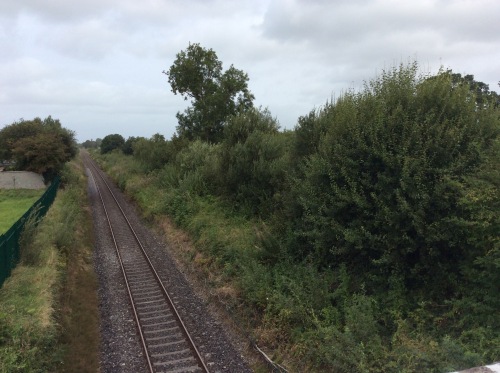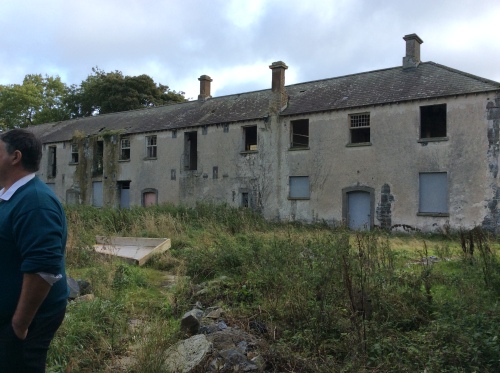
Newtonwforbes in County Longford is a small village located just a few miles outside Longford town, on the busy N4 Dublin to Sligo road. Originally known as Lisbrack (Lios Breac in Irish), the name was changed to Newtownforbes in the middle of the 18th Century by the Forbes family, who were granted the lands here in the early 1600s. The Forbes family, with the title Earls of Granard, have lived in the village for over 300 years.

The gates to Castle Forbes are in the middle of the village.

Castle Forbes, the seat of the Earls of Granard (Image accessed on Flickr)
The present Castle was constructed in the 19th Century – the original built c.1624 was destroyed by fire. As this is a family home, the entire demesne is private and not open to the public.

Introduced Grey Squirrel (Image Wikipedia)
In 1911, the grey squirrel was introduced here. An indigenous species of North America, several pairs were given as a wedding gift to a member of the Forbes family in 1911. A number escaped and went on to breed prolifically and almost annihilate the native Irish red squirrel. Fortunately the progress of the grey squirrel seems to have finally been halted in recent years, and the red squirrel is again increasing in numbers.

The main street in Newtownforbes has remained largely unchanged over the decades with modern development confined largely to side streets. Two churches dominate the village, both provided by the Forbes family. The Church of Ireland church of St. Paul, built about 1820, replaced an earlier church from 1694. The graveyard here has been mapped and recorded by a local team of dedicated volunteers lead by Doreen McHugh and Des Mooney. The earliest recorded burial dates to 1698. The results of their work can be seen on the Historic Graves website. See the link below.

St Paul’s Newtownforbes

Door at St. Paul’s

The Graveyard at St Paul’s

Information on surnames
There is a Forbes family crypt in this churchyard and interestingly, and unusually I would think, there is another Forbes family mausoleum attached to the Roman Catholic Church of St. Mary’s.

The Mausoleum at St Pauls. Beatrice, Countess of Granard (1883-1972)

The Forbes Mausoleum at the Roman Catholic Church . c 1880

Forbes family coat of arms.

Remains of 7th Earl and his wife Jane repose here
The Catholic Church of St Mary’s, where I was baptized, is in the centre of the village. This is the parish church of Clonguish. It has been almost totally remodelled in recent times.

Clonguish RC parish Church
However, it used to look like this:
The ‘explanation’ for this dramatic change appears on this plaque at the side of the church. It would appear that the term ‘restoration’ can have a very broad meaning!

Plaque marking the 1974 work on the RC Church in Newtownforbes.
Either side of the main entrance door are two carved heads, which may or may not represent specific people. These are part of the original church, built 1861-1864.

One of two carved faces at main entrance

One of two carved faces at main church door
I had hoped that some of the interior survived the renewal, in particular the baptismal font at which I was christened, but I was to be disappointed. With the possible exception of the brass sanctuary lamp, some stained glass windows and the mosaic memorial to the local nobility, everything else seems to be modern.

Main Altar St Mary’s, Newtownforbes

Lovely stained glass windows with mosaic memorial.

More stained glass windows

Original(?) brass sanctuary lamp
The new round stained glass window is very attractive and compliments the interior. The original side aisles have been removed and everything within seems to be very modern.

New round window and new pine ceiling

Modern stained glass window
Returning to this little village in the midlands of Ireland is always poignant. The Station House, in which we were born and where we spent many happy times with our grandparents, was built in the 1860s and closed as a railway station in 1963 . It is now a beautifully maintained private residence. It is always nice to stand on the little bridge and look down to the place where we made many happy memories.

Newtownforbes Station House, where our grandparents lived
The railway line is still in use. I have lovely memories of walking along the line with my grandfather. The main telephone lines ran on poles along the line in those days. and he used to lift me up and place my ear against the poles to hear them ‘singing’.

The Dublin – Sligo line is still in use although the station is closed.
It was always exciting to cross over this little bridge as we knew we had arrived for more adventures!

The railway bridge at Newtownforbes Station
Quite near the Station is the abandoned Lisbrack House. Most recently a nursing home, it was once a school and a bishop’s home. To the best of my recollection our mother was taught to play the piano in this building by a very cranky nun who was also a great pianist!

Former Lisbrack House
Another prominent religious site on the main street is the Convent of the Sisters of Mercy. About 1869 the nuns were invited here by the Earl of Granard who provided the site for the buildings to enable them to educate the children of the estate. An orphanage and industrial school were also established here. Sadly this site had a role in the tragic legacy of such establishments in Ireland. The school and convent are now closed and I understand that these rather nice buildings are now apartments.

The convent chapel

Convent Building
The village has many buildings from the 19th and early 20th centuries. The two storey tudor style house is one of a pair provided for estate workers and it was in these that County Longford’s first flushing toilets were installed.

A Tudor style house built for estate workers – among the first in the county to have flushing toilets!
Many of the houses would would have originally been thatched and unfortunately many are no longer occupied.

Varied housing styles

Original lsash windows in this little cottage

The same cottage from across the street

No longer occupied

The village hall
The former RIC Barracks built c. 1900 was burned during the War of Independence. It was later rebuilt for the use of the Garda Siochana (Irish Police) and is now a private residence.

The former Newtownforbes RIC Station
This interesting item is the Famine Pump. It was provided by Lord Granard as a Famine Relief scheme. It sits alongside a building that started life as a shooting range in Longford army barracks. It was purchased by a local who erected here c.1933 and is known locally as Christy’s Hall.

Famine Water Pump and Christy’s Hall
The hard work of the local tidy towns volunteers is evident throughout the village.
And local junior artists have also been decorating the hoarding surrounding the former school buildings.
A board inside the church lists the townlands in the parish of Clonguish, which derives from the Irish ‘Cluain Geis’ which means The Meadow of the Swans.

Newtownforbes is the last resting place of our grandparents and an uncle and aunt so visits nowadays are to pay respects at their graves in the new cemetery.

Entrance to the ‘new’ cemetery

The ‘old’ catholic cemetery now largely unused

Newtownforbes old RC Cemetery
One of the great delights of my brief visit discovering a great little restaurant called Tús Nua right on the main street, so if you happen to be passing through, drop in for a wee wander through this quaint little village and enjoy a fabulous coffee in this delightful coffee house!

References
http://historicgraves.com/graveyard/newtown-forbes/ld-spnf
http://http://catalogue.nli.ie/Record/vtls000317412
Home
 Those of us who live around Midleton, a small town in the east of County Cork, Ireland, are very proud of an impressive art installation that marks a very poignant moment in Irish history.
Those of us who live around Midleton, a small town in the east of County Cork, Ireland, are very proud of an impressive art installation that marks a very poignant moment in Irish history. This sculpture honours an extraordinary gift from the Choctaw Native Americans to the starving Irish during the Great Famine that raged through Ireland in the 19th Century. It was created by Alex Pentek at the Sculpture Factory in Cork, Ireland and installed in Bailick Park, Midleton in 2015.
This sculpture honours an extraordinary gift from the Choctaw Native Americans to the starving Irish during the Great Famine that raged through Ireland in the 19th Century. It was created by Alex Pentek at the Sculpture Factory in Cork, Ireland and installed in Bailick Park, Midleton in 2015.
 The sculpture consists of nine 20-foot (6.1 m) stainless steel eagle feathers arranged in a circle, to represent an empty bowl.
The sculpture consists of nine 20-foot (6.1 m) stainless steel eagle feathers arranged in a circle, to represent an empty bowl.















































































